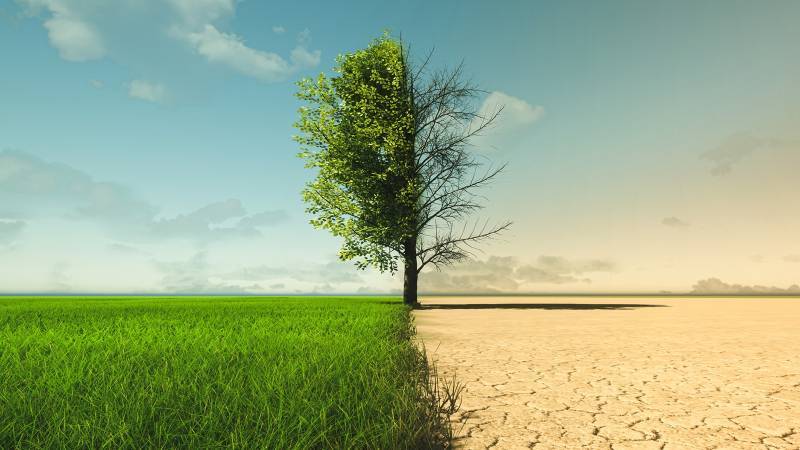
The amount of heat trapped in the atmosphere, according to reports, is equivalent to the detonation of five Hiroshima-class atomic bombs every second for the past 25 years. Climate change is undeniably real, and the time to act is now
Pakistan, a country, home to 248 million people, contributes less than 1% to climate change; however, it is the sixth most vulnerable country in the world to climatic disasters. The floods of 2022 resulted in large-scale displacements and a loss that accumulated to approximately USD 30 billion. Rising sea levels pose an existential threat to coastal areas and biodiversity. Thar, once home to millions of cattle is now facing drought.
Third-world countries, due to a low carbon footprint and lack of finance are not in the position to mitigate climate change; however, they can transform their infrastructure and focus on climate resilience in order to adapt to climatic disasters.
One of the avenues to adapt and build resilience towards climatic disasters is modern Urban Planning. It will act as the first line of defence against unforeseen events. Some of the initiatives Pakistan can adopt are as follows:
Mass Transit: According to reports, 35% of the pollutants that contribute to smog come from vehicular emissions. A substantial growth in cars, as seen in Pakistan, not only emits harmful gasses but also leads to growing congestion, increasing the average time taken for commute. A Mass Transit system, operated in the city of China, Guangzhou, caters to 1.2 million people a day, is highly efficient, and reduces carbon emissions. A recent initiative of EV busses taken by the Punjab Government is commendable and it needs to expand all over the province in order to reap the full benefits of this green transformation.
Smart Agriculture: Pakistan has gone from an agriculture-exporting country to a food-insecure country due to climate change. With 7.9 million people facing acute food insecurity in 2024, the declining water table and extreme temperatures pose an existential threat to the fifth most populous country in the world. The Netherlands, 19 times smaller than Pakistan, exports $65 billion worth agricultural products all over the world, which is approximately three times Pakistan’s total exports. The Netherlands adopted the smart agriculture technique of vertical farming that uses 90% less water while giving 5 times the output compared to conventional farming. With the use of AI, plant health, crop water requirements, and the acidity of the soil are monitored which boosts productivity. The Government must invest in smart agriculture in order to avert the growing food insecurity and rise again as a major agriculture exporting country in the international market.
Pakistan, equipped with sunlight throughout the year, and high-speed winds on the Makran coast, shall transform its infrastructure to wind and solar power in order to adapt to climate change and mitigate the negative impacts of greenhouse gas emissions
Renewable Energy: As of 2024, renewable energy only accounts for 6.8% of Pakistan’s energy mix. The use of imported fuel and coal not only puts a burden on the country’s current account but is also harmful to the environment. Furthermore, in the midst of climate change, the international pressures on the use of coal also pose a risk to the country’s energy security. Hence, Pakistan, equipped with sunlight throughout the year, and high-speed winds on the Makran coast, shall transform its infrastructure to wind and solar power in order to adapt to climate change and mitigate the negative impacts of greenhouse gas emissions.
Mixed-use Development: Modern urban planning takes a holistic view of city life and it infuses the community life back that is evading from our urban sprawls. Mixed-use development focuses on planning cities that allow its citizens to live within a 15-minute radius and conduct their business. From having schools, hospitals, workplaces, supermarkets, parks, and leisure activities within a 15-minute radius — citizens are not bound to commute over long distances, saving time, cost, and carbon emissions.
Green Roofs: Rotterdam, a city in Amsterdam, once prone to frequent flooding provides a model to avert urban flooding. Green roofs are a model whereby office buildings, parking plazas, and large roofs are covered with greenery and water-absorbing plants. In the event of extreme rain, water is absorbed and the runoff is collected via pipes in large tanks or ponds. This not only reduces the risk of flooding but also cools down the temperatures inside the buildings, reducing the need for air conditioning.
Sponge City Model: One of the major causes of urban flooding in Pakistan is lack of sewerage resulting in accumulation of water on the streets. As the name suggests, the Sponge City model, perfected in Hebi City, China works like a sponge for rainwater harvesting. The footpaths are designed in a way that they have horizontal spaces in them that allow rainwater to seep through and are then stored in underground tunnels.
Biophilic Design: According to the official figures, only 2.5% of Pakistan is forested. The green cover is degrading every day due to construction work and horizontally multiplying housing societies. At this rate, the country will lose whatever is left of its green cover and ultimately stand at risk of worse droughts, extreme temperatures, and poor air quality. The biophilic model, championed in Singapore, focuses on planting an equal amount of plants and trees that are cut for construction purposes. Large buildings are mandated to have winter gardens that are equipped with plants and trees. It boosts human interaction with nature while also preserving the environment.
Amidst the ongoing climate crises, along with other necessary measures, a mix of modern urban planning while learning from international best practices, is pertinent for Pakistan to avert this serious threat that poses an existential challenge to the future of our planet.

